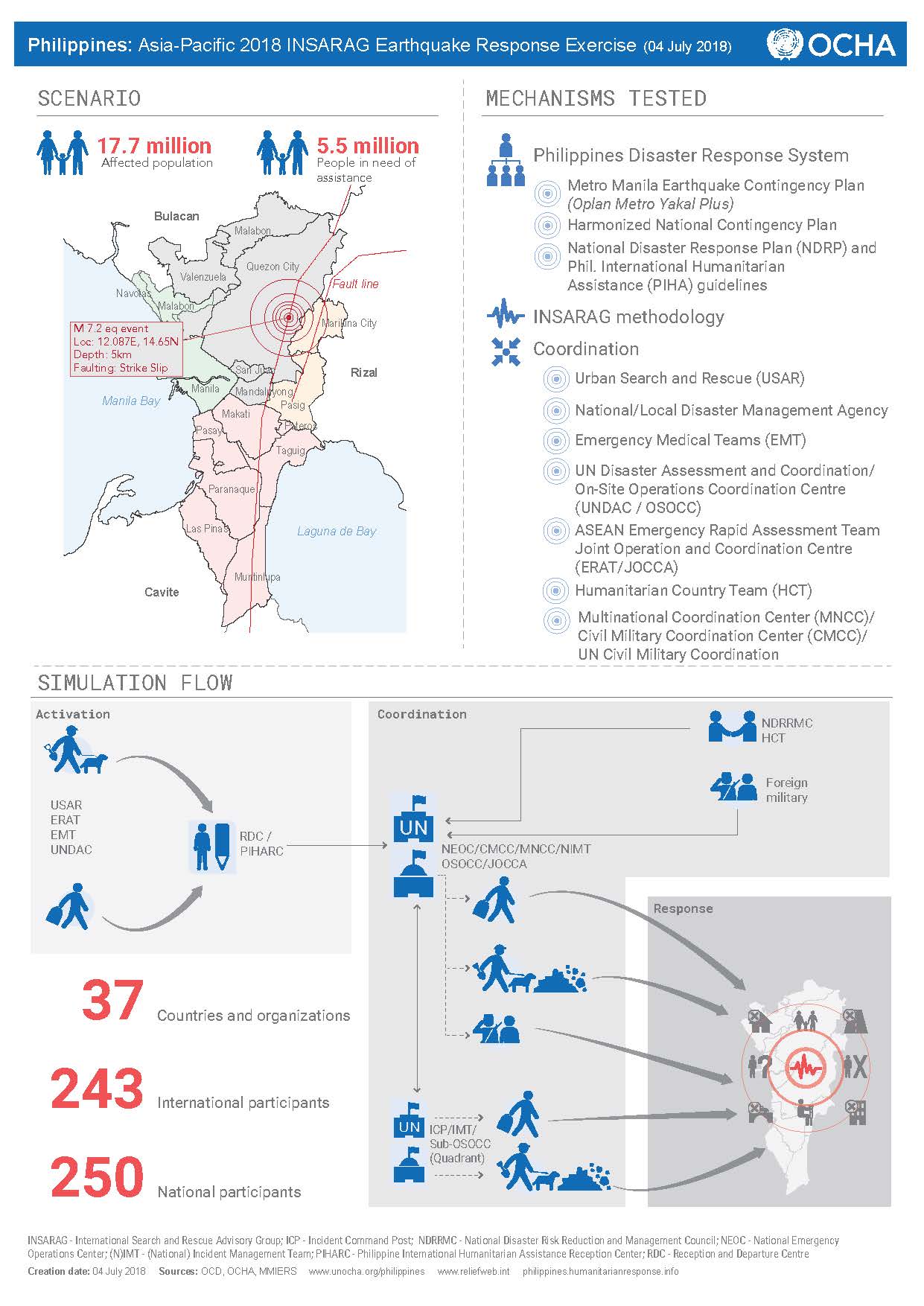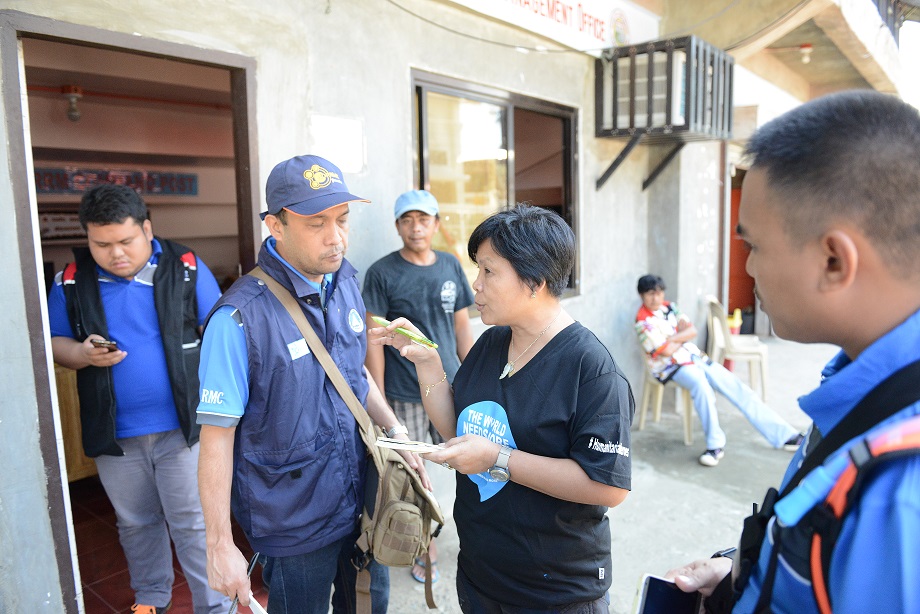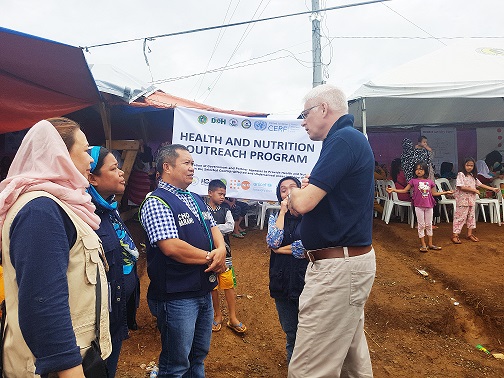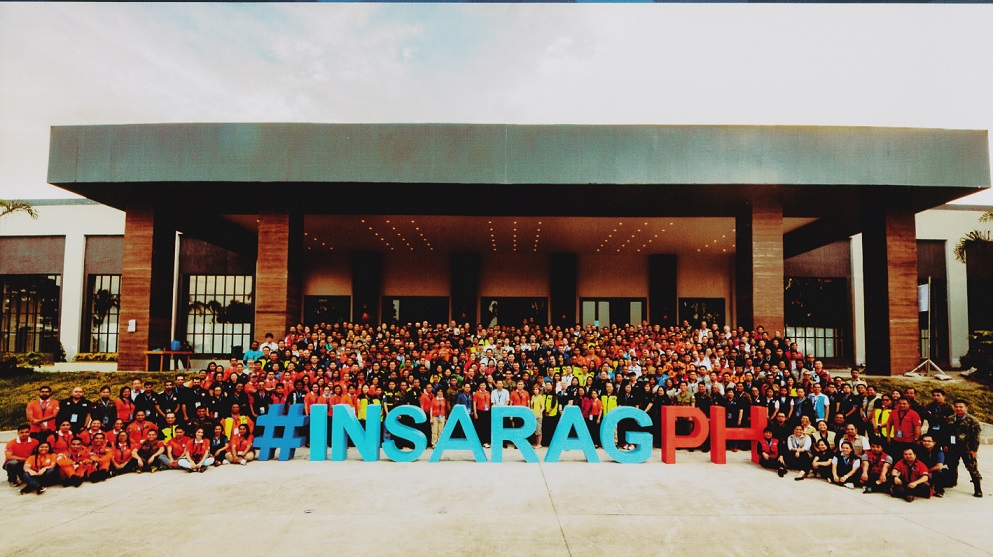
Philippines hosts 2018 INSARAG earthquake response exercise
The 2018 International Search and Rescue Advisory Group (INSARAG) Asia-Pacific earthquake response exercise was held in Clark, Pampanga, Philippines from 26 to 29 June 2018. The exercise, hosted by the Philippines Government and organized by the National Disaster Risk Reduction and Management Council (NDRRMC) through the Office of Civil Defense (OCD), and OCHA as the INSARAG Secretariat, aims to practise national and international response and coordination methodologies based on a humanitarian response to a worst case 7.2-magnitude earthquake affecting Metro Manila.
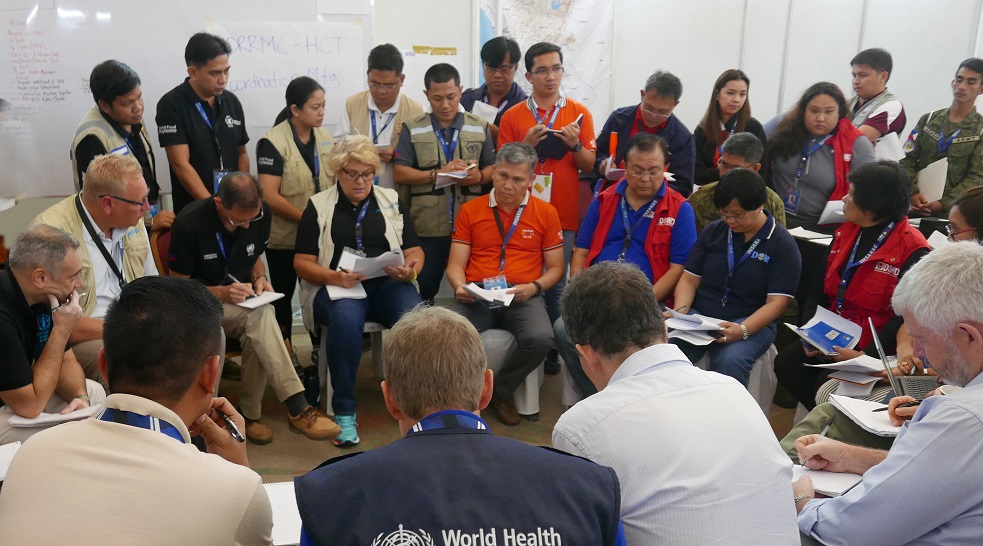
Credit: OCHA/T. Arao Clark, Pampanga (27 June 2018) - A joint meeting between NDRRMC Executive Director Ricardo Jalad (center), Department of Social Welfare and Development (DSWD) Director Rodolfo de Villa, Jr., the Inter-cluster coordination group and the Humanitarian Country Team during the INSARAG exercise.
Biggest INSARAG exercise in the region
The tabletop exercise gathered more than 500 participants from 34 countries and international organizations representing national/local responders, urban search and rescue (USAR) teams, emergency medical teams (EMT), UN and ASEAN assessment and coordination teams (UNDAC/ERAT), Humanitarian Country Team (HCT), and foreign militaries.
The Philippines hosted the exercise in 2004 and 2008, but this year’s edition drew the largest number of participants, with the civil-military coordination functional group tested for the first time.
Nationally-led, internationally-supported response
Mr. Ola Almgren, the UN Resident Coordinator/ Humanitarian Coordinator in the Philippines, in his remarks emphasized that while standing ready to respond, the international humanitarian community is supporting the government’s efforts around capacity building and understanding of best practices that can be implemented during a response, and in ensuring that international humanitarian partners are able to support and plug into national response systems effectively and efficiently.
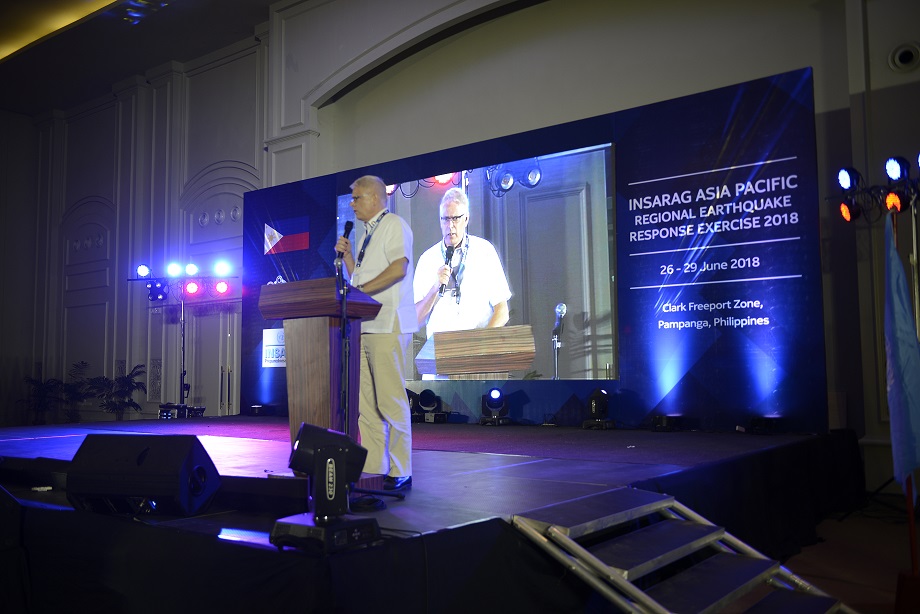
Credit: OCHA/G. Maramag United Nations Resident and Humanitarian Coordinator in the Philippines Ola Almgren addresses participants of the INSARAG exercise.
For the government, the exercise was an opportunity to practise its newly endorsed Enhanced Policy Guidelines on Philippine International Humanitarian Assistance (PIHA) which provides for the framework in managing international assistance, specifically procedures in the deployment of international relief workers, and mobilization of financial and inkind resources.
A component of the PIHA guidelines is the establishment of the Philippine International Humanitarian Assistance Reception Center (PIHARC) in port of entries for screening and registering the entry of international teams, equipment and relief items. Similarly, the international humanitarian coordination system has the Reception Departure Centre (RDC) – set up by the first arriving USAR, EMT or UNDAC team members – which delivers situational and operational briefings, provides basic logistical support, and facilitates the operational activities of the response teams.
Mr. Mirza Khan of the Singapore Civil Defence Force has participated in the last four editions of the exercise and remarked that “this year’s exercise was an eye opener for the international teams, especially that ASEAN countries have put in place national frameworks for managing disaster response and increased their capacities in coordinating international response. The discussion should now focus on how the international system could support existing country mechanisms, in this case, how the RDC could interoperate and reinforce, rather than duplicate the PIHARC.”
Solidarity between the United Nations and ASEAN disaster response teams
The exercise also saw the continued joint deployment of the United Nations Disaster Assessment and Coordination (UNDAC) team and the ASEAN Emergency Response and Assessment Team (ERAT), including the co-location of the On- Site Operations Coordination Centre (OSOCC) and the Joint Operations Coordination Centre for the ASEAN (JOCCA), to support the government in coordinating the assistance of ASEAN members, the UN and other international organizations.
According to Secretary Delfin Lorenzana, the Chairman of NDRRMC and Secretary of the National Defense, the exercise allows local rescuers to supplement existing capacities in USAR which further strengthens the country’s national response capacity.
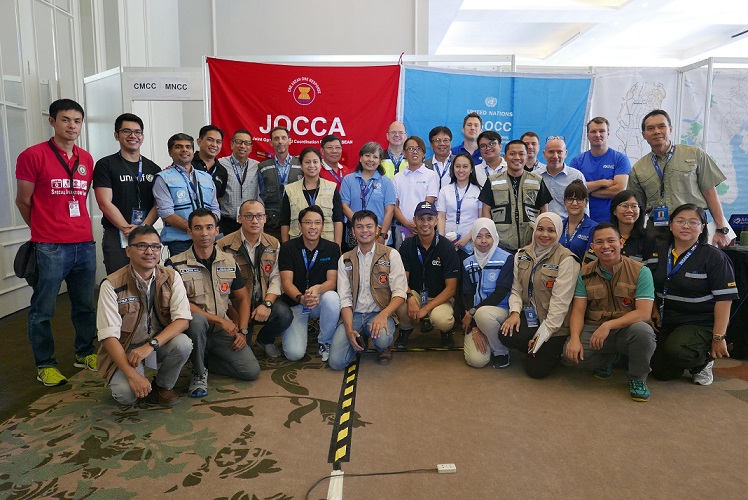
Credit: OCHA/T. Arao Clark, Pampanga (29 June 2018) - Members of the Humanitarian Country Team with the ASEAN-ERAT and UNDAC teams.
Mr. Winston Chang of OCHA Geneva and the INSARAG Secretariat, who served as this year’s exercise director, underscored that the INSARAG is a community of practice that continuously learns from its members and that the lessons and best practices from the Philippines exercise will further enrich coordination and response mechanisms at the global and national levels.
INSARAG external classification
The Philippines’ hosting of the 2018 exercise is one of the 20 recommended short, medium and long-term requirements from the USAR capacity assessment mission conducted by the INSARAG Secretariat in 2016. The recommendations which focused on policy, leadership and governance, training, and equipment and facilities are intended to provide the strategic roadmap for the Philippines’ national USAR team towards classification as defined by the INSARAG Guidelines.
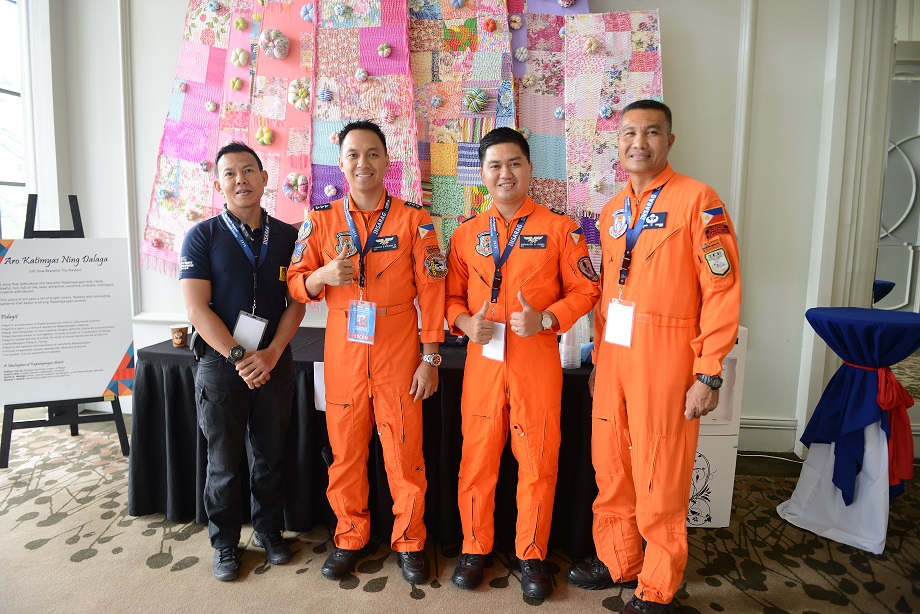
Credit: OCHA/G. Maramag Clark, Pampanga (29 June 2018) - Urban Search and Rescue teams from the Philippine Air Force participated in the five-day INSARAG exercise.
USAR teams from the Philippine Army, Philippine Air Force, and the private/civil society Emergency Rescue Unit Foundation (ERUF) will initially compose the Philippine Disaster Relief Team which will aim for a medium INSARAG classification. Classification would allow the Philippines to join 51 teams worldwide that can currently be deployed, under UN auspices, to respond to earthquake emergencies around the world.
The government has committed to sustain the development of its USAR capabilities, particularly in pursuing the INSARAG external classification to reciprocate the assistance which the country has received in past disasters.
International solidarity: participating urban search and rescue teams
BAN 1 Bangladesh and the China International Search and Rescue Team were among the 243 international participants from 37 countries and organizations.
Bangladesh BAN 1 team
Lt. Col. Zulfiker of BAN 1 Bangladesh said that their team learned about the “whole emergency response scenario from top to bottom”, sharing that they will be trying to conduct the exercise with other members back home. They built relationships with other USAR teams and are looking forward to future mentorship as their own team gets certified. “We have plenty of experience responding as Bangladesh is a disaster-prone country, with frequent flooding and tropical cyclones. This exercise is so helpful for us to learn the mechanisms as we try to get our team classified.”
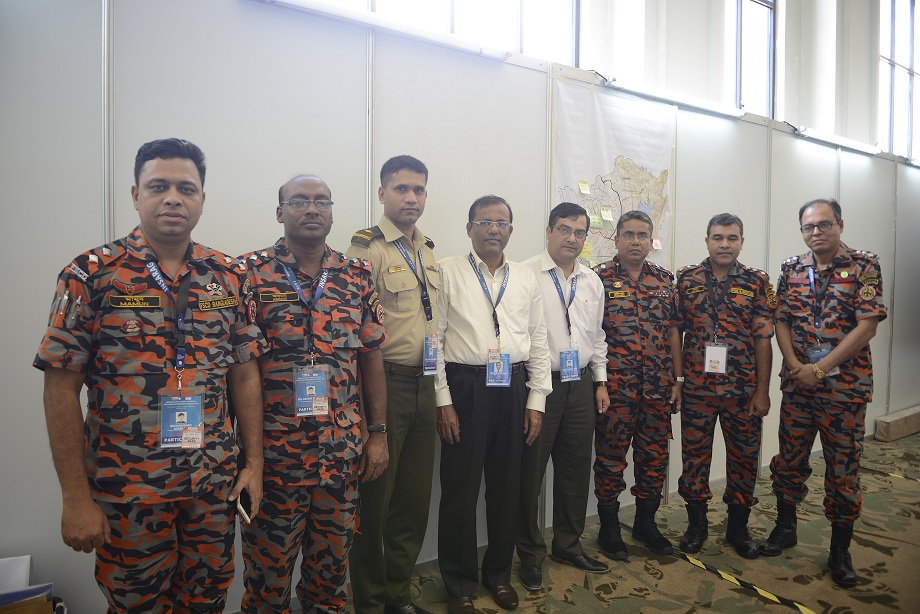
Credit: OCHA/G. Maramag Clark, Pampanga (29 June 2018) - The Bangladesh search and rescue team.
China's International Search and Rescue team
The China International Search and Rescue team has a total of 480 members, with seven participating in the exercise. “We have participated in several INSARAG exercises hosted by Malaysia and Indonesia, and we learned a lot from the Philippine exercise. We can learn a lot from each other, exercising our INSARAG mechanisms not just on paper,” said Chen Siyu, a member of the team. “We look forward to sharing our learnings with the rest of the team.”
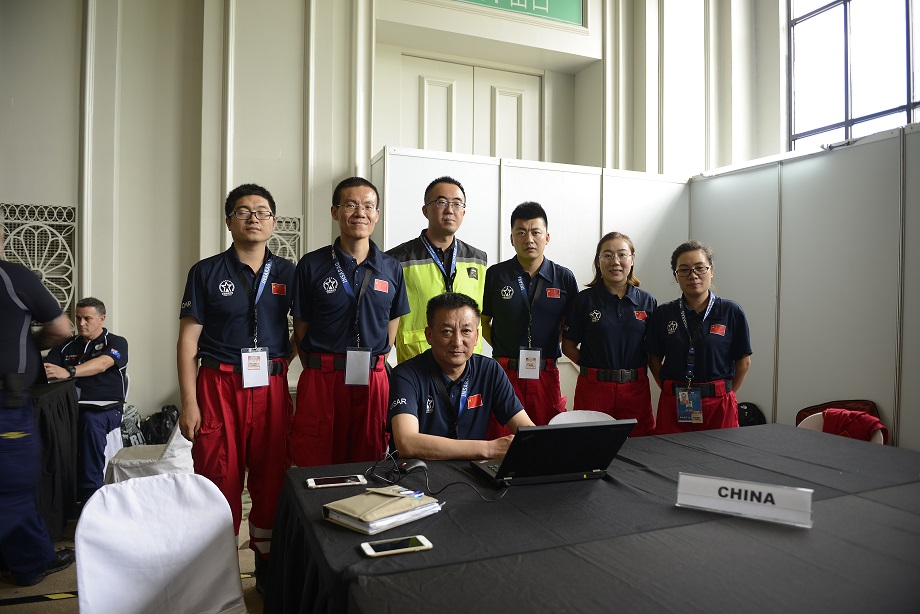
A component of the PIHA guidelines is the establishment of the Philippine International Humanitarian Assistance Reception Center (PIHARC) in port of entries for screening and registering the entry of international teams, equipment and relief items.
INSARAG is a community of practice that continuously learns from its members. The lessons and best practices from the Philippines exercise will further enrich coordination and response mechanisms at the global and national levels.
"We can learn a lot from each other, exercising our INSARAG mechanisms not just on paper." - Chen Siyu, China International Search and Rescue Team
UNDAC in the Philippines
The United Nations Disaster Assessment and Coordination (UNDAC) commemorates 25 years of responding to sudden onset emergencies in 2018. Created in 1993, it assists the United Nations and governments of disaster affected countries during the first phase on emergencies, assisting in the coordination of international relief. UNDAC teams usually deploy within 12-48 hours notice, anywhere in the world and at the request of UN Relief Coordinator, Humanitarian Coordinator, or Government.
Assessment, coordination and information management are UNDAC's core mandates in an emergency response mission. Specifically in response to earthquakes, UNDAC teams set up and manage the On-Site Operations Coordination Centre (OSOCC) to help coordinate international Urban Search and Rescue (USAR) teams responding to the disaster.
UNDAC support to the Philippines
In addition to their support in the recent INSARAG exercise in Philippines, UNDAC teams deployed in response to emergencies in 2004 (flooding and landslides in Luzon), 2006 (Typhoon Durian), 2009 (Typhoon Ketsana, Nari and Parma), 2012 (Typhoon Bopha), and 2013 (Typhoon Haiyan). An UNDAC response preparedness mission was also conducted in 2005.
Philippine UNDAC members
There are currently four active Philippine nationals on the UNDAC team. Two are from the UN in the Philippines, and two from the Office of Civil Defe nse and the Armed Forces of the Philippines.
Agnes Palacio of the UN Office for the Coordination of Humanitarian Affairs (OCHA) was recently featured in UNDAC’s Women on the frontlines of humanitarian response, which features the unique perspective of what it means to be part of a team of international first emergency responders. “Being an UNDAC member is an opportunity: to meet other people, to have a network of colleagues who share the same advocacies, to have an understanding of how other cultures cope with a disaster situation,” say Agnes. “The best part is that anything you contribute you know is for the greater good…that you are also advocating for the needs of the entire community.” She has been a member since 2004, responding to the Pakistan earthquake in 2005, Myanmar Cyclone Nargis in 2008, and the Nepal earthquake in 2015.
To qualify for active status, an UNDAC member should be deployed at least once a year for disaster response or response preparedness missions. The rapid deployment has made it inhibitive for more members to participate, and OCHA is currently advocating with participating organizations to develop policies to allow for overseas missions of their members.
Created in 1993, UNDAC assists the United Nations and governments of disaster affected countries during the first phase on emergencies, assisting in the coordination of international relief.
UN Resident and Humanitarian Coordinator in the Philippines visits Marawi City
On 30 June, Mr. Ola Almgren, UN Resident Coordinator/ Humanitarian Coordinator in the Philippines visited Marawi City to meet with displaced communities, humanitarian responders of the UN and local partners. He spoke with women from Sarimanok 1 and 2, which were constructed by the Government as a temporary shelter before they are able to transfer to a site with better facilities in the village of Sagonsongan.
“We are not sure when we will be able to return home,” says Mariam, “but we are happy with the privacy we get here as compared to the crowded shelters in Iligan. However, we lack the easy access to hospitals, schools and markets in Iligan, including food and water supply”. The displaced women also expressed concern on the durability of their tents especially during heavy rains. “When heavy rains pours, I am always afraid that our tent will be washed away. It is not durable," shared Dalia. The women also expressed the need for livelihood assistance. “We need startup capital to restart the small businesses we had before we fled Marawi”.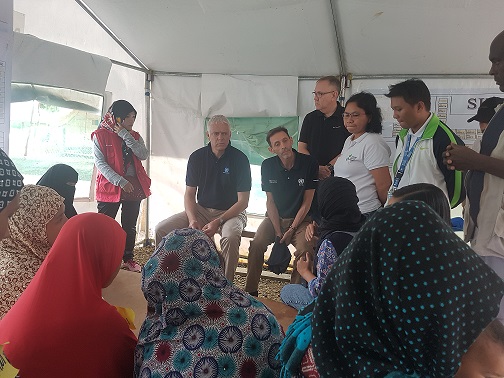
Credit: OCHA/S. Taulani Marawi City, Lanao del Sur (30 June 2018) - The Humanitarian Coordinator in the Philippines Mr. Ola Almgren (left), with OCHA Philippines Head of Office Mark Bidder (center) listen to women who are seeking shelter at the transitional site Sarimanok 1
Renewing commitment to address humanitarian needs
The camp is managed by the City Social Welfare Office which is working closely with agencies both from the Government and humanitarian community to ensure the delivery of clean water and sanitation. Mr. Almgren reinforced the continuing commitment of the Humanitarian Country Team, composed of UN agencies and international and national non-governmental agencies. “We will continue to work with the Government to address the needs of displaced people,” says Mr. Almgren.
In Sarimanok 2, the Humanitarian Coordinator visited a mobile health clinic supported by the United Nation Central Emergency Response Fund (CERF), and met with the Marawi City Health Officers, Dr. Ali Dalidig. Dr. Daligdig discussed the timeliness of humanitarian interventions “in addressing the health needs of internally displaced people (IDPs) in the camps”, says Dr. Daligdig. In order to maximize the impact of the CERF grant, the health cluster has agreed to converge CERF projects that include mobile health services, reproductive health, and nutrition.
Meeting with Mindanao humanitarian actors
The Humanitarian Coordinator also visited the destroyed barangays in the most affected areas, saying that “it is an entirely different experience to be physically here to see the extent of devastation caused by the conflict.”. It will take time for the most affected areas to be cleared of unexploded ordnances and other hazardous munitions before reconstruction can begin. The Government’s rehabilitation plan is near completion and estimated to be rolled out in September 2018 and may take three years to complete.
Mr. Almgren met with humanitarian actors supporting the early recovery needs of the displaced population. “I encourage that you continue to work together as a team to coordinate better the response and maximize limited resources,” he said. He also stressed that the Marawi conflict response needs go beyond Marawi City where large number of municipalities affected in Lanao del Sur continue to face poverty and limited social services over the years. He also said that a challenge will be sustaining funding to continue assistance for early recovery needs in support of the Government. There is a need to provide a mid- to long-term solutions to people in the province, hoping peace will prevail in the region.
The UN Resident Coordinator/ Humanitarian Coordinator in the Philippines visited Marawi City to meet with displaced communities, humanitarian responders of the UN and local partners.
The Humanitarian Coordinator also stressed that the Marawi conflict response needs go beyond Marawi City where large number of municipalities affected in Lanao del Sur continue to face poverty and limited social services over the years.
